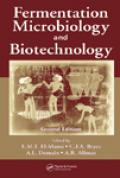
Cover 

Fermentation Microbiology and Biotechnology, Second Edition
Author:ISBN10: 849353343
ISBN13: 9780849353345
Publisher: CRC Press
Price: $89.95
Pages: 576
Edition:
Publish date: October 2006
Outline:
Employs a significant number of case studies and industry examples specifically designed to support principles and methods introduced in the text Provides definition boxes throughout the text to illustrate and introduce the reader to new scientific terms and concepts Discusses fermentation microbiology's diverse applications in the pharmaceutical industry Includes new chapters on the latest research highlighting current advances and future directions The pace of progress in fermentation microbiology and biotechnology is fast and furious, with new applications being implemented that are resulting in a spectrum of new products, from renewable energy to solvents and pharmaceuticals Fermentation Microbiology and Biotechnology, Second Edition builds on the foundation of the original seminal work, extending its reach to reflect the multidisciplinary and expansive nature of fermentation research and advancements. While retaining valuable information from the previous edition including a brief history of the industry, as well as an overview of instrumentation and fermentor design, fermentation kinetics, and flux control analysis, the second edition addresses numerous topics that have risen to prominence in the past few years. New chapters explore the diverse array of microbial biosynthetic pathways currently used by the fermentation and pharmaceutical industries for the production of primary and secondary metabolites such as amino acids, vitamins, antibiotics, immunosuppressants, and anti-tumor agents. The authors also examine recent advances in enzyme and co-factor engineering and cell immobilization with respect to both novel drug development and improved yields from microbial processes. Beyond pharmaceuticals, this volume considers the emerging role of fermentation in the conversion of renewable resources to fine chemicals, as well as its potential use in converting lignocellulosic waste to ethanol. In addition, readers will also discover new chapters devoted to discussions of industrial issues such as modeling and sensor technology, as well as supervision and control in the fermentation process. The text is packed with examples and case studies from the industry, carefully chosen to illuminate and reinforce principles and methodology discussed in the chapters. Organized and written in a concise and lucid manner that requires only a general background in microbiology, this volume meets the needs of students, academic researchers and industrialists, particularly those involved in creating and improving product formations through fermentation.
index page


 companies
companies books
books